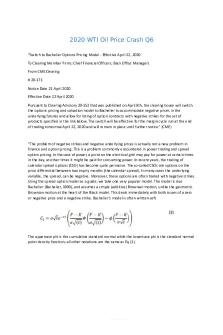2020 WTI Oil Price Crash Q6 PDF

| Title | 2020 WTI Oil Price Crash Q6 |
|---|---|
| Course | Introduction to Derivative Securities |
| Institution | Curtin University |
| Pages | 2 |
| File Size | 110.1 KB |
| File Type | |
| Total Downloads | 80 |
| Total Views | 142 |
Summary
Download 2020 WTI Oil Price Crash Q6 PDF
Description
2020 WTI Oil Price Crash Q6 “Switch to Bachelier Options Pricing Model - Effective April 22, 2020 To Clearing Member Firms; Chief Financial Officers; Back Office Managers From CME Clearing # 20-171 Notice Date 21 April 2020 Effective Date 22 April 2020 Pursuant to Clearing Advisory 20-152 that was published on April 8th, the clearing house will switch the options pricing and valuation model to Bachelier to accommodate negative prices in the underlying futures and allow for listing of option contracts with negative strikes for the set of products specified in the link below. The switch will be effective for the margin cycle run at the end of trading tomorrow April 22, 2020 and will remain in place until further notice.” (CME)
“The problem of negative strikes and negative underlying prices is actually not a new problem in finance and option pricing. This is a problem commonly encountered in power trading and spread option pricing. In the case of power, a point on the electrical grid may pay for power at certain times in the day, at other times it might be paid for consuming power. In recent years, the trading of calendar spread options (CSO) has become quite pervasive. The so-called CSOs are options on the price differential between two expiry months (the calendar spread). In many cases the underlying variable, the spread, can be negative. Moreover, these options are often traded with negative strikes. Using the spread option model as a guide, we take one very popular model. The model is due Bachelier (Bachelier, 1900), and assumes a simple (additive) Brownian motion, unlike the geometric Brownian motion at the heart of the Black model. This deals immediately with both issues of a zero or negative price and a negative strike. Bachelier’s model is often written as:
The uppercase phi is the cumulative standard normal while the lowercase phi is the standard normal point density function; all other notations are the same as Eq (1).
There are known modifications that will allow Black’s model to price options on products with negative prices. With a very minor change of variables, we can “displace,” or shift, the underlying variable of the model. In the case of oil, we could say that the random variable is M + the futures price. M is an arbitrary constant which is large enough to deal with potential negativity. In order to be consistent, we also shift the strikes by this amount as well....
Similar Free PDFs

2020 WTI Oil Price Crash Q6
- 2 Pages

Q6 ans
- 6 Pages

Crash
- 12 Pages

WTI SS19 Tut1 Lsg
- 5 Pages

5 - Q6 explained
- 1 Pages

Q6-PAU-Acidos YBases
- 17 Pages

Nosa course price list 2020 v2
- 7 Pages

Garland Chocolates Q5 n Q6
- 1 Pages

Volatile Oil
- 9 Pages

Snow Crash
- 8 Pages

Price Effect
- 18 Pages

protocolo PRICE
- 3 Pages

Crash course Linear Algebra
- 95 Pages
Popular Institutions
- Tinajero National High School - Annex
- Politeknik Caltex Riau
- Yokohama City University
- SGT University
- University of Al-Qadisiyah
- Divine Word College of Vigan
- Techniek College Rotterdam
- Universidade de Santiago
- Universiti Teknologi MARA Cawangan Johor Kampus Pasir Gudang
- Poltekkes Kemenkes Yogyakarta
- Baguio City National High School
- Colegio san marcos
- preparatoria uno
- Centro de Bachillerato Tecnológico Industrial y de Servicios No. 107
- Dalian Maritime University
- Quang Trung Secondary School
- Colegio Tecnológico en Informática
- Corporación Regional de Educación Superior
- Grupo CEDVA
- Dar Al Uloom University
- Centro de Estudios Preuniversitarios de la Universidad Nacional de Ingeniería
- 上智大学
- Aakash International School, Nuna Majara
- San Felipe Neri Catholic School
- Kang Chiao International School - New Taipei City
- Misamis Occidental National High School
- Institución Educativa Escuela Normal Juan Ladrilleros
- Kolehiyo ng Pantukan
- Batanes State College
- Instituto Continental
- Sekolah Menengah Kejuruan Kesehatan Kaltara (Tarakan)
- Colegio de La Inmaculada Concepcion - Cebu


